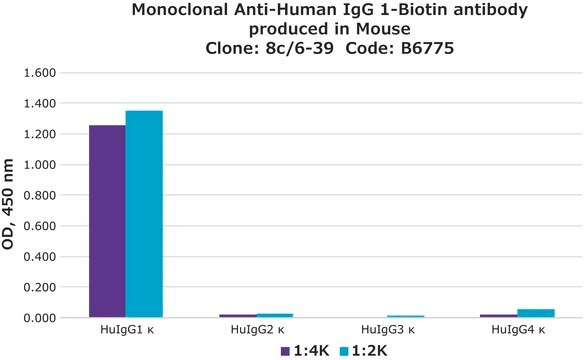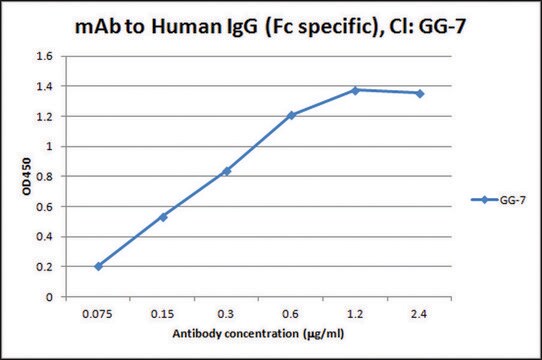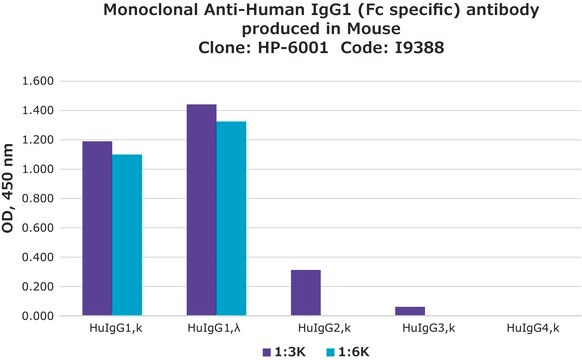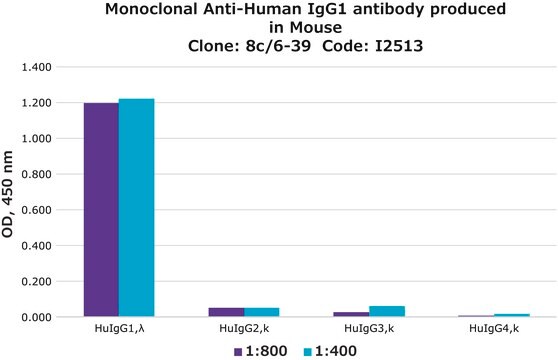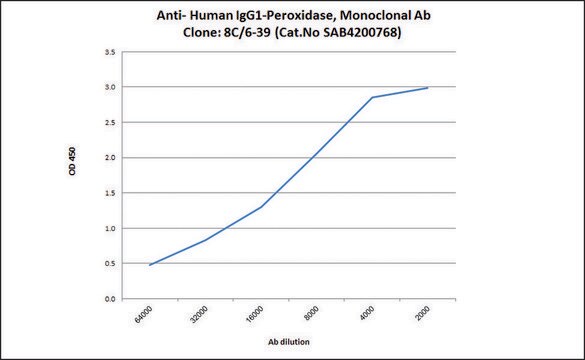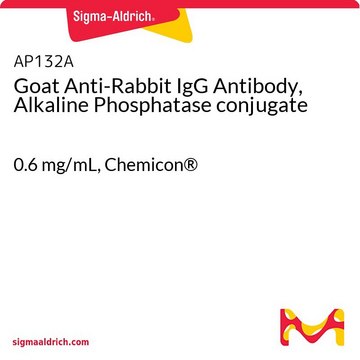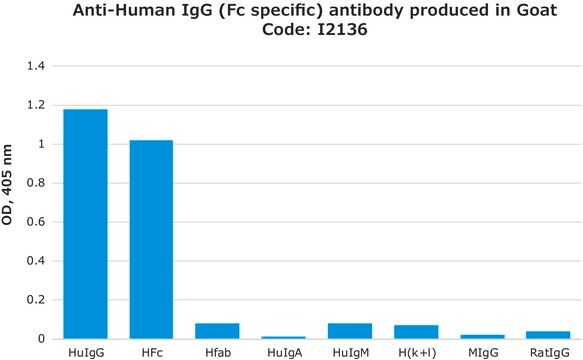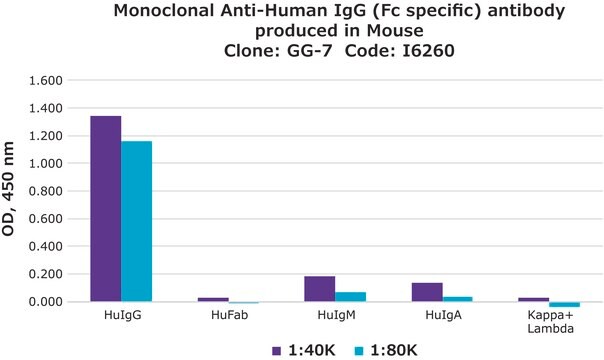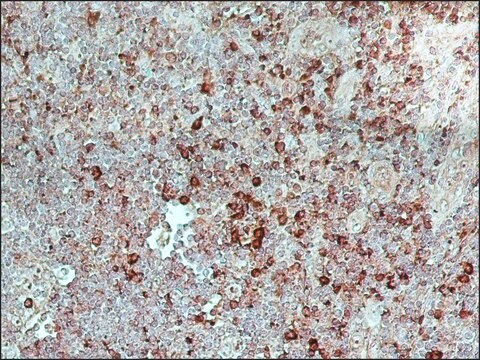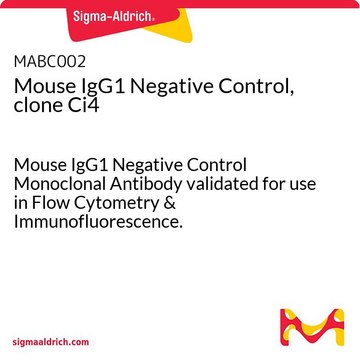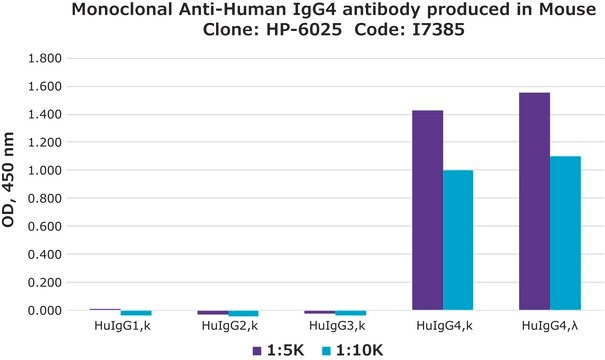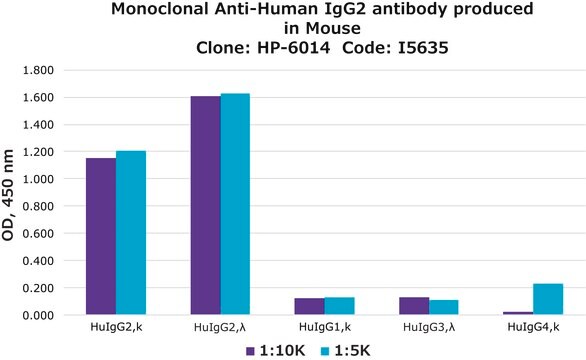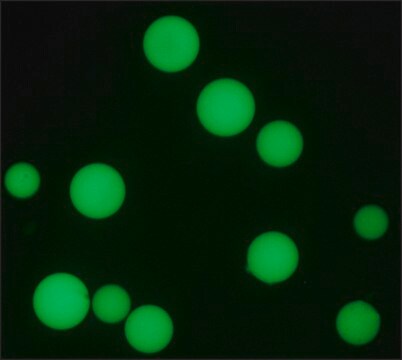おすすめの製品
由来生物
mouse
品質水準
抗体製品の状態
purified from hybridoma cell culture
抗体製品タイプ
primary antibodies
クローン
8C/6-39, monoclonal
フォーム
buffered aqueous solution
交差性
human
濃度
~1 mg/mL
テクニック
indirect ELISA: 3-6 μg/mL using Human IgG1 myeloma protein for coating.
アイソタイプ
IgG2a
輸送温度
dry ice
保管温度
−20°C
ターゲットの翻訳後修飾
unmodified
詳細
Human IgGs consist of four subclasses (1-4) that can be recognized by antigenic differences in their heavy chains. They constitute approximately 65, 30, 5 and 4% of the total IgG, respectively. Each subclass has different biological and physiochemical properties. The IgG subclass may be preferentially produced in response to different antigens and pathological conditions. For instance, anti-polysaccharide responses are mainly of the IgG2 subclass while protein antigens give rise to IgG1 and IgG3 antibodies. Human IgG1 is the predominant subclass of in vivo and in vitro produced anti-tetanus toxoid antibodies. IgG1 and IgG3 are the only subclasses capable of adherence to mononuclear phagocytes and are recognized readily by the Fc receptors on various reticulo-endothelial cells while IgG2 and IgG4 are far less efficient. The amount of the different IgG subclasses present in the bloodstream varies with age. For example, IgG1 and IgG3 reach normal adult levels by 5-7 years of age while IgG2 and IgG4 levels raise more slowly, reaching adult levels at about 10 years of age. Serum IgG subclass deficiencies have been recorded for different patient groups. For example, a disproportionate elevation of IgG1 has been found in the cerebral spinal fluid of patients with multiple sclerosis. Examination of the distribution pattern of IgG subclasses in different types of diseases may provide insight into the immunological processes involved and thus may assist in the diagnosis of various disorders.
免疫原
The Fc fragment of a human IgG1 myeloma protein.
アプリケーション
Indirect ELISA: a working concentration of 3-6 μg/mL is recommended using 10 μg/mL Human IgG1 myeloma protein for coating.
物理的形状
Solution in 0.01 M phosphate buffered saline, pH 7.4, containing 15mM sodium azide.
その他情報
In order to obtain best results in different techniques and preparations we recommend determining optimal working concentration by titration test.
適切な製品が見つかりませんか。
製品選択ツール.をお試しください
保管分類コード
10 - Combustible liquids
WGK
WGK 3
引火点(°F)
Not applicable
引火点(℃)
Not applicable
適用法令
試験研究用途を考慮した関連法令を主に挙げております。化学物質以外については、一部の情報のみ提供しています。 製品を安全かつ合法的に使用することは、使用者の義務です。最新情報により修正される場合があります。WEBの反映には時間を要することがあるため、適宜SDSをご参照ください。
Jan Code
SAB4200786-100UL:
SAB4200786-VAR:
SAB4200786-BULK:
最新バージョンのいずれかを選択してください:
この製品を見ている人はこちらもチェック
B Rocchelli et al.
European neurology, 22(1), 35-42 (1983-01-01)
The IgG oligoclonal bands in CSF can be found in high percentage of MS patients but the existence of a limited number of cases with CSF normal IgG profile is known as well. In the present study 63 out of
R Stevens et al.
Journal of clinical immunology, 3(1), 65-69 (1983-01-01)
Peripheral blood leukocytes from individuals immunized with tetanus toxoid can be stimulated by pokeweed mitogen to produce IgG anti-tetanus toxoid antibody (IgG-Tet) in vitro. Previous studies have shown that treatment of these cells with tetanus toxoid or anti-human IgG reagents
F W van der Meulen et al.
British journal of haematology, 46(1), 47-56 (1980-09-01)
The purpose of this study was to determine whether quantitative or qualitative factors are of major importance in the destruction of red cells sensitized with incomplete warm autoantibodies of subclass IgG1. To that end, the relative amount of igG1 antibody
R Jefferis et al.
Immunology letters, 10(3-4), 223-252 (1985-01-01)
Seventy-four monoclonal antibodies (McAb) of putative specificity for human IgG (11), the IgG sub-classes (59) or Gm allotypes (4) have been evaluated for reactivity and specificity in eight laboratories employing different assay techniques or protocols. For the IgG, IgG3, IgG4
ライフサイエンス、有機合成、材料科学、クロマトグラフィー、分析など、あらゆる分野の研究に経験のあるメンバーがおります。.
製品に関するお問い合わせはこちら(テクニカルサービス)